
Rukhsana Khan
Profile by Dave Jenkinson.
Books by Rukhsana Khan.
Visit Rukhsana Khan's website at http://www.rukhsanakhan.com
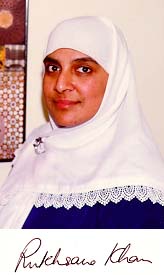 Born in Lahore, Pakistan, on March 13, 1962, Rukhsana Khan moved with her
family first to Britain and then, about a year later at age three, to
Canada."When we came to Canada in the Sixties, racism was 'in your face.'
We lived in Dundas, Ontario, which then had a population of about 16,000
people, and only two of the families were Indian. My father worked at a
tool and die company, and his coworkers used to call him 'black bastard'
right to his face. They hardly ever called him by his name, and he put up
with it because he had four kids to feed. My father had chosen to live in
Canada because he wanted to get away from those cultural influences which
said girls are expendable. He also wanted to raise us as Muslims, and he
wanted a good neighborhood."
Born in Lahore, Pakistan, on March 13, 1962, Rukhsana Khan moved with her
family first to Britain and then, about a year later at age three, to
Canada."When we came to Canada in the Sixties, racism was 'in your face.'
We lived in Dundas, Ontario, which then had a population of about 16,000
people, and only two of the families were Indian. My father worked at a
tool and die company, and his coworkers used to call him 'black bastard'
right to his face. They hardly ever called him by his name, and he put up
with it because he had four kids to feed. My father had chosen to live in
Canada because he wanted to get away from those cultural influences which
said girls are expendable. He also wanted to raise us as Muslims, and he
wanted a good neighborhood."
"It turned out to be very difficult.
Because we stuck out so much, we were persecuted from day one. If it
hadn't been for that negative treatment, I don't think I would have become
a writer because my growing up was so horrible that I went to books to
escape. Having no friends, I spent my recesses among the trees. I used to
think a lot, and that's when I really came to terms with what my beliefs
are, who I am, and what my place is in the universe. I also read a lot,
tons of books, and some have stayed with me. Shadow of a Bull by
Maia Wojciechowska was one. I loved Eloise Jarvis McGraw's Mara,
Daughter of the Nile, a book I almost stole from the library. Growing
up, I didn't know you could buy books. We bought Muslim books but never
other books. I must've read Mara ten times. I fell in love with one
of the characters, Sheftu, and would be just completely immersed in the
book. Finally I had to return it, and I thought, 'I'll tell the library I
lost it.' I had it under my mattress for about two months until my
conscience got the better of me. Mara's the book that got me into
historical fiction. I read lots of Geoffrey Trease and Elizabeth George
Speare. I liked adventure just to get me away from where I was. When I was
about 13, another book I loved was Jane Eyre. It was a defining
book for me in terms of who I was."
"When I went from grade six to grade
seven, it was a different school, but the kids who'd been bullying me
previously told all the other kids, and they ganged up on me there. In
high school, I turned myself around and became very outgoing. I went up to
all kinds of people and learned how to make a buffer zone around myself. I
had some friends and wasn't alone any more. I was still a target, but not
such an easy one. In grade 11, there was one boy who'd always come after
me. He called me 'lice-mobile' in the hallway, and I'd try not to turn
around. One time in home room, he asked, 'Who's a Paki lover?' and Sharon,
one of the prettiest girls in the class, went up to him and said, 'I am.'
That shut him right up. After that, he never bugged me in home room
although he still called me stuff in the hallway. I guess I could've gone
up to Sharon and tried to be her friend, but, socially, she was way up
there, and here I was, and I was kind of more embarrassed because she
stood up for me."
Rukhsana married at 17, but her husband
encouraged her to stay in school. "After I got married, we came to
Scarborough. I had changed so much. I was outgoing and confident. I was 18
when I graduated, and then I went on to two years of community college
where I became a biological-chemical technician. I'm still married to the
same man, and we have four children, three girls and a boy."
However, despite her present happiness,
Rukhsana reveals just how horrific the effects of the school taunting had
been. "There was a moment in grade eight where I thought of committing
suicide because the kids' picking on me was so bad. I had no friends, and
I remember that, at one point, the kids gave me a gift, a dog collar. It
was just horrendous and unbelievable now. The thing that really saved me
was my faith and the fact I knew that, if I killed myself, I'd burn in
hell."
Given the ongoing emotional abuse of
public school, it is surprising that Rukhsana credits the school
environment with being responsible for her becoming a writer. A positive
force was Rukhsana's grade eight English teacher whom she describes as
"fabulous. He gave us a creative writing assignment of writing one thought
in a journal every day. When I handed mine in, he wrote me a beautiful
long note that said I was a writer. I thought, 'Nah, I'm not a writer.
Writers are white and from England or America.' But then something started
in me, and I thought, "I'd love to be able to write the stories that I
love to read." When I was 14, I wrote a novel, 'Carla, the Gypsy Girl,'
that's about 278 pages of handwritten text. I still have it. It was about
a gypsy girl who's a dancer, but she's secretly a Muslim. She marries the
Duke of Lester, and they have all these adventures. The story rambled on
until I ran out of stuff for them to do, and then it just kind of died."
"When I was 16, I was trying to impress
a lady I was babysitting for, and so I wrote a little picture book, 'Waldo
the Worm, for her kids. At the time, my mother was a cleaning lady for an
English professor from McMaster University, and she told him about my
story. He liked it so much that he sent it to a New York editor friend of
his. I thought, 'Wow! I'm going to get published.' Instead, I got a
rejection letter in which the editor said that it was a nice story for a
little girl to have produced, and it would take time to become published
if I kept trying. I was furious with the letter and the 'little girl'
comment because I was 16. Something, however, kept making me write. When I
was pregnant with my oldest daughter, I wrote a lullaby for her. I wrote
songs, and then I started writing stories for a community magazine. I was
still writing, and I didn't realize it. Ten years later, I found the
letter again, reread it and realized, 'Wait a minute. She's encouraging
me.' I also found 'Waldo,' rewrote it and sent it off, expecting it to get
published. It didn't."
"After about five rejections of the
rewritten 'Waldo,' I thought, 'Maybe I should do some more research.' I
went to the library and talked to one of the librarians who suggested,
'Perhaps you should take a course.' 'Who needs a course to write for
children?' thought I. After another few rejections, I realized I did, and
so I took one at the Canadian Children's Book Centre with Peter Carver.
Then I took Barbara Greenwood's course, and that gave me the structure I
needed. I had lots of story ideas, but I didn't know how to put them into
a structure that could make them good stories that one kids could relate
to."
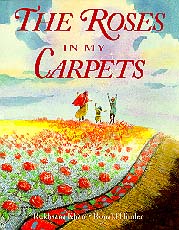
Just when Rukhsana seemed about to
achieve some success, she encountered publishing difficulties. "I'd gotten
my first story, 'The Shade of Shalimar,' as well as The Roses in My
Carpets and Bedtime Ba-a-a-lk accepted by Kathy Lowinger at
Lester Publishing. She was the first editor who took me seriously."
Unfortunately, Lester ceased publishing, and, while Kathy Lowinger moved
to Tundra Books, the accepted manuscripts went to Stoddart. Rukhsana
notes,"The funny thing was that Stoddart's Katherine Cole had previously
rejected 'The Shade of Shalimar.' Now that she had it back, I didn't want
her to bring it out. While she told me she liked the story, she said it
was too esoteric for kids. In retrospect, I'm glad it didn't get
published. When you put your name on your work, it's got to be the best
book because that could be the only thing that people would read of yours,
and they'll judge the rest of your work by that one book."
Though Katherine Cole had rejected
'Shalomar,' she viewed The Roses in My Carpets much more
positively. "Katherine told me that reading Roses gave her goose
bumps. She brought an American publisher, Holiday House, on board because
'Roses wasn't the type of story that a grandmother would buy her
grandkids because it's not a happy little story.' She wanted an American
co-publisher so that she could it take it to Stoddart's marketing people."
Bedtime Ba-a-a-lk beat Roses into print "because
Bedtime took less time to illustrate. Since Holiday House, as
co-publisher, had a say in who was going to illustrate Roses, it
took about a year to find an illustrator. They tried a lot of different
people before eventually deciding on Ronald Himler."
"In some ways I think The Roses in My
Carpets is my best book. It's the one that's most important to me. I
based it on a true story, and, because I took my foster child's story, I
thought it only fair to give half of the royalties to refugees. The sister
of my Afghani foster child was four when she was hit by a truck and both
her legs were broken, and I hadn't even known about it. I met her in 1992
when I went to Peshawar, Pakistan. Then, she was about 10-years-old and
running around fine. The photos I took during the visit were later
instrumental in the illustrations because I sent them to Ronald Himler who
lives in Tucson, Arizona. One, a family photo, is what made me write the
story. In it are Kareem, my foster child, his mother, little sister and
older brother. The brother was sitting with his knees drawn up, his hand
to his mouth, looking like he was terrified. During school presentations,
I show this picture and tell the kids it's the one that made me write
Roses. I try to get the 'why' out of them before coming to the
brother's face and telling them, 'Part of being a writer is imagining what
it feels to be somebody else. When I looked at this photograph, I tried to
imagine: What does it feel like to be him?' Even though, technically, the
brother's not in the book, it's actually about him."
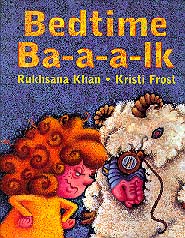
However, the text found in Roses
was not what Rukhsana first wrote after returning to Canada. "When I was
visiting my refugee foster child, I stayed with some friends to whom I
promised that I would go back to Canada and write something for the
refugees. I wrote a story about going to visit my refugee foster child,
and I sent it to The Toronto Star and all kinds of publishers.
Nobody was interested, and I put it away. In 1994, one of the friends I'd
stayed with was injured and came to Canada for health reasons. When I
visited him in hospital, he asked, 'What happened to the story you were
going to write?' I replied, 'I wrote it, but nobody wanted it.' And he
inquired further, 'What did you do with it?' 'I put it away,' I responded.
'You mean you quit,' he said. I felt so bad I decided to go home and
rewrite it. I took the rewritten version to my writers' group which
consists of one Christian lady, one Jewish lady and me. We've been
together for about 10 years. I read it out, and they gave me some
suggestions, but I still thought, 'They just don't understand how
important this story is to me.' I then shared it with my husband's cousin
who loves refugee causes. She said, 'It's dead.' I was flabbergasted, but
I realized, 'Wait a minute. She's right.' I decided to chuck what I'd
written and to start again from scratch. I was looking over the
photographs, thinking maybe they would spark something, when I came across
this family portrait. 'That boy! Write it from his perspective.'"
"However, I didn't begin writing
immediately. I think what is so important as a writer is to let things sit
so that it grows and adds layers. I was thinking, 'Ok, what can I do?' I
liked the idea of carpet weaving because that was one of the trades the
refugees were taught. Then I came across the idea, 'What if the colours
mean something?' I used to exercise every morning to one of the TV workout
shows, and I noticed that the host's carpet had chrysanthemums in it. I
thought, 'Oh, they're pretty, but what if they were roses?' And so it
started coming together. Then, all of a sudden, I heard the first line"
'It's always the same. The jets scream overhead.' 'I've got to write
this,' and I sat down and wrote it. When I was finished, I was shaking."
Rukhsana's faith could be considered
responsible for her creating the humourous Bedtime Ba-a-a-lk.
"Because we're Muslim, we have to pray five times a day. Fajr has always
been my bane. It's the hardest prayer because you have to get up before
sunrise. While I was trying to become a writer, I used to babysit a lot.
One summer I was babysitting two preschool children who were really awful.
Being summer, we had to wake up at 4:30 a.m. for Fajr. This one morning, I
couldn't get back to sleep, and I thought, 'Oh gosh. Those kids are coming
at 7:30, and I'm going to be so tired.' I tried going back to sleep, but I
just tossed and turned. Then I got the idea, 'Maybe if I count sheep?' I
made my mind all blank, made a fence and some sheep and said, 'Ok sheep.
Start jumping.' One of the sheep who was chatting, instead of starting to
jump, looked at me like, 'Who the heck are you?' And I thought, 'Forget
about sleeping,' and I sat in bed handwriting Bedtime Ba-a-a-lk."
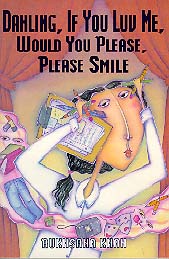
After two picture books, Rukhsana's next
published work was the middle school novel, Dahling, If You Luv Me,
Would You Please, Please Smile. The catchy title is actually a line
from a drama exercise. Basically, the novel's about adolescent alienation
and the various "costs" of trying to fit in socially. The central
character, Zainab Chaudry, 13, is the only Muslim in her school, and, with
the exception of Premini Gupta, a Hindu, the only "Indian." Already a
social outcast, Zainab is the sole eighth grader not wearing this year's
in-brand of jeans. A caring teacher tries to improve Zainab's social
standing by putting her in charge of a school play, thereby placing her in
contact with the "popular" students. Unfortunately, his action only
creates a new set of problems for Zainab at school and at home. Rukhsana
adds other forms of alienation, including that of blonde Jenny Roberts.
From a poor, single parent home, zit-faced Jenny has "huge breasts" which
attract the interest of Kevin, the school hunk, who agrees to cooperate
and be in the play if Jenny will "cooperate."
"I started Dahling in 1992.
Originally it was called 'The Dumb Banana Years.' When I do classroom
presentations, I hold up both Dahling and Roses, and tell
the kids, 'Both this novel and this picture book took me the same amount
of time to write, four years. Dahling's first draft is almost the
same as the finished book, but people who read that manuscript kept asking
me, 'Why doesn't the younger sister just tell the older sister to take a
hike and leave her alone?' I reworked that aspect, making it much more
subtle. I made Layla, the older sister, much more manipulative, so that
she really corners Zainab and checkmates her so she cannot move. When I
gave people the second draft, nobody asked that question again. They
realized Zainab's completely outmaneuvered. I was surprised at how
Dahling all came together towards the end. I wasn't even aware of
how a lot of it was going to come together, but it did. Premini surprised
me as a character. I had no idea she was going to be that good an actress
until the auditions when she just came out with the Shylock speech. I was
actually planning to have her as one of the villains."
Rukhsana explains that the initial idea
for Dahling was an incident in grade eight. "We had an orientation
to go to the high school, and, at that point, I was desperate for friends,
and so I tagged along with this group. At the end of the day, someone
said, 'Let's go to the bathroom.' While I was in one of the cubicles, they
took off on me. I shouted 'Wait!' and hurried after them. When they looked
back and saw me, they started running faster. I stopped and walked back to
the high school where, as I sat and waited for the bus, I thought, 'You
know what? Never ever run after anybody to be your friend.' When I write,
I have to have the climax. I don't need to know the ending because it will
come, but I need to know the turning point, that climax, and I could see
these girls back in grade eight. The whole point of Dahling is
where Zainab thinks, 'Their approval is not worth it.' There's a parallel
stuff going on in Dahling with Zainab's relationship with Layla,
but it's much more subtly done."
"When I'm writing, it's like there's a
room in my head where the characters are cavorting. Every once in a while,
they'll let me peek through the door and see something that's going on,
and then they close the door, shutting me out. With Dahling, I was
'shut out' for about six months. I'd set myself a July deadline, and it
was May, and I still had 11 chapters to rewrite. I was stuck at that point
where Zainab is humbling herself before Kevin. She balked and wouldn't
'do' anything. She said, 'No. I'm not doing it.' Thinking about what I'd
written, I realized I'd had Zainab tell exactly what she says to Kevin.
'Wait a minute!' I thought. 'If somebody is humiliating themselves, they
don't tell you word for word what they've said.' And that was why Zainab
was balking. She just told me, 'Yah, I humiliated myself,' and so it was a
matter of my summarizing that without going into detail. Once I got past
that, I breezed through the 11 chapters in about five weeks and met my
deadline."
Buxom Jenny came from the afternoon talk
shows. "I used to watch Sally Jesse Raphael, and I was amazed at all these
vulnerable young girls doing all kinds of stupid stuff to please their
boyfriends. They're ruining their lives. Some kids hate Jenny. They think
she's weak, but I don't. She's just vulnerable and a little bit misguided.
Underneath it, Jenny's actually a smart girl, and, towards the end, I
wanted to show that aspect of her. I also wanted to show that she stands
up for Zainab at the beginning, even though she succumbs to pressure."
"Another girl wrote saying she loved
Dahling but was so disgusted with Kevin and Premini. She thought
Premini was such a racist. Actually, Premini is racist, but she's very
real. People don't realize the way minorities talk about white people, and
I've heard 'Premini's' all my life. I put her in there to give the other
side of the equation. I also wanted to show the racism that's between the
Muslim and the Hindu."
An interesting subplot in Dahling
is Zainab's Muslim home life. "I was scared because I didn't want to make
any of the Islamic information sound didactic, and yet, when you finish
reading Dahling, you come away with a feeling of what Islam is
about and what Muslims are. I did that on purpose because really part of
it is to educate, and yet it's also the backdrop."
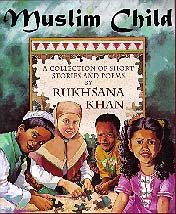
Younger students seeking information
about Islam can turn to Rukhsana's next book, Muslim
Child, a collection of stories and poems relating to Islam. This
work is connected to the two women in Rukhsana's writing group. Sydell
Waxman wrote Changing the Pattern, published by Napoleon, and she
introduced Rukhsana to Sylvia McConnell at Napoleon, while Patty Gallinger
did the illustrations for Muslim
Child. "Sylvia was interested in my writing even before my books
started coming out, and, when I pitched the Muslim
Child idea to her, she liked it. Some of the stories I'd
previously written. For example, 'Fajr' was done about 10 years ago, and
it circulated through some Muslim magazines. I structured Muslim
Child about the basic tenets of Islam because there are the five
pillars of Islam. Belief's the first, and then prayer, fasting, charity
and the Hajj. The other major aspects are dress, food, Eid, and the
history. I found it really hard to do a story about the Prophet Muhammad
[peace be upon him] as we're not allowed to show any pictures of him.
Writing the stories was difficult because, unlike the fiction, I had to
write to inform and yet, as a writer, I still had to create stories with
kid appeal. In Muslim
Child, I stuck to the religion and only put in the stuff that is
universally done all over the world while staying away from anything
that's only particular to one culture."
The act of creation sometimes takes
writers in directions different than those intended. A real happening
became the basis for a picture book manuscript, 'The Red Lollipop.'"When
we came to Canada, I was three, and my older sister, Rubina, was six and
in grade one. One day, when she came home with a birthday party
invitation, I said, 'I wanna go too. I wanna go too.' 'No, you can't
come,' replied Rubina. 'Why not?' asked my mother because in Pakistan the
whole family is invited. I continued to beg until my mom told Rubina, 'You
have to take your little sister.' At the party, we got loot bags which,
among other things, contained a big red lollipop. I ate mine on the way
home, but Rubina stuck hers in the fridge, saving it for later. The next
morning, a Saturday, I woke up first and went to watch cartoons. Looking
in the fridge for something to eat, I saw the lollipop. I tried to resist.
In the story I wrote, there's a bump on the side of the lollipop, and, the
little girl, in trying to 'fix' it, shatters the lollipop, leaving just a
triangle. When the lollipop broke in real life, I thought, 'Oh no.
Rubina's going to kill me,' but then I remembered my mother's having said,
'It's good to clean up a mess,' and so I ate the pieces and left just the
triangle. When Rubina woke up, the first thing she did was go the fridge.
Being just three, I knew only one place to hide, the front closet. Rubina
realized where I was hiding, and the chase began. Hearing my yelling, my
mother came downstairs and asked, 'What's going on?' I said, 'Rubina's
trying to kill me.' Rubina complained, 'She ate my lollipop.' To which my
mother responded, 'For shame. It's just a lollipop. Can't you share with
your little sister?' Running to the fridge, I showed my mother, 'See. I
didn't eat all of it.' Rubina took the lollipop fragment and threw it.
Seeing it ending up under the sofa, I concluded, 'OK, she doesn't want
that either,' and so I finished it." If the scene seems familiar, it found
its way into chapter 6 of Dahling.
But the lollipop incident has also
evolved beyond Dahling's chapter. The original picture book
manuscript went to Holiday House for consideration as an "easy reader."
"The editor replied, saying, 'We really like it, but it contains too many
deep concepts for an easy reader.' She asked me to expand it into a small
novel for grades three and four. In the rewriting process, it snowballed
so that now it's at a point where I really know the title and what I'm
trying to do. Called 'Little Apartment in the New Country,' which is a
take on Little House on the Prairie, it's an immigration story
about coming to Canada and what it feels like in terms of the racism. It's
an episodic book with lots of funny stuff going on between the sisters,
but there's also some other darker currents running throughout. The
title's clunky, I know, but I think it'll work really well, especially
when I bring in the parallelism of Little House on the Prairie. The
main character, Sadaf, reads Little House in grade one or two, and
she loves it and comes to see the parallels with her own situation.
Because I like first person, most of my books are in that voice, but I
couldn't write 'Little Apartment' in first person. The character's too
young to appeal to the group that would be reading about her, and yet she
needs to be young in order for it to work. Consequently, I had to go into
third person."
"Racism's still occurring in Canada, but
it's much more subtle. In 'Little Apartment,' there's one scene where,
Annie, a good friend of Sadaf, while visiting, sees a picture of the baby,
Nyla, and comes out with the comment, 'Oh, isn't that so cute. You know
little brown babies look just like baby monkeys.' Sadaf is absolutely
horrified because they just did evolution in school, and, if you look at
the evolutionary chart, we're all aiming to be that white man at the end.
I'm working the whole thing about evolution into the story because of the
conceptions we had about brown skin when I was growing up. The white kids
told me, 'You're dirty. You're brown because you've got mud on you, and
you come from a dirty area.' And they really believed that, but I can't
use that example in a contemporary story. I hated having to set this book
back in the Sixties, but I had to. The Sixties aren't exactly a pioneer
age, but, in a way, they are because of where we've come since back then."
Rukhsana's next book, The Kite
Thief, illustrated by Rick Jacobson and Laura Fernandes, will be
published by Scholastic in the fall of 2000. "It's about a crippled boy
who, one day in a year, reigns supreme. It's the day of Basunt, the Kite
Festival. He goes up on his rooftop, and, on this day, he's like the king
of the sky. I like the opening line. '"I can't walk and I can't run, but I
can fly. And on the day of the sun I am king of the sky. Ha. Ha," he
said.' When I was in Pakistan, they told me about Basunt, and I thought,
'That would be kind of neat, and then the idea came.' The title comes from
the fact that people rub ground up glass into the kite strings and 'fight'
with their kites, trying to cut the other kite strings."
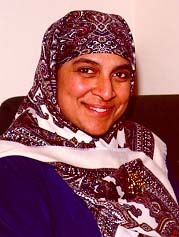
"After that, I don't have anything
awaiting publication. I've a story, 'Apricots and Mangos,' which is about
a man whose family is really stupid. It's a Persian version of 'The Three
Sillies,' only it's got four. That story is at three publishers right now.
I also have a novel, 'Rebel With a Scarf,' that I want to write after my
'darn epic.' It's going to be a sequel to Dahling, and my husband
tells me I should be writing it first to follow up on Dahling's
success. I agree, but 'the darn epic' is calling me, and I have to write
it."
"The darn epic," as Rukhsana
affectionately calls it, is an historical novel which has been "nagging"
Rukhsana for some time. "The idea of girls' being expendable is something
I've always been wanting to counteract with my writing. Since I was 16,
I've had this idea of a story set in ancient Arabia. I knew back then I
didn't have the equipment to write it, but I tried. I got one or two
chapters into it and thought, 'I need to research this.' But it's one of
those ideas that won't let go. While it's going to be an adult novel, I
think youths will read it too. I want to write a novel set back at the
time of Prophet Muhammad [peace be upon him]. There was a practice then of
burying daughters alive, and I'm going to write about a boy who tries to
save his sister from that fate. In my teens, I was very idealistic and was
going to change the world, and my central character thinks that way too.
It'll be a bit of a romantic love story, but a lot of my love stories
don't end up the way they're supposed to. That's why I spelled 'love' in
Dahling as 'luv' because it's not real love, and I didn't want
people to think it was a romance novel. Since there are all kinds of
interactions in the plot of 'the darn epic,'it's taking a long time to
write. Twenty-one years and counting. But I'm getting there."
"Mostly I write on the computer, but I
did Roses at the kitchen by hand because, sometimes, you need to
slow the story down. If you write too fast, you're going to lose it.
Muslim
Child was a bit of both because I can't write on the
computer and write slowly enough. I find sometimes I need that time
between the words to think. I usually have to do the first line, and it's
a very much an aural thing. One story I wrote, 'Supertoad,' came to me
just after I finished praying. I heard this voice in my ear say, 'I am
Supertoad, defender of the weak and helpless,' I thought, 'Oh, I have to
write this. It's funny.' I sat up and wrote down as much as I could. I
think it's hilarious, but I haven't got it published yet. Sometimes I find
picture books harder than novels."
"I try to set aside time to write, but,
with all the school presentations I've been doing, it's hard. I attempt to
get a lot done during the summer. My husband's great. He supports me in
everything I do. Ten years ago, when I told him that I had dreams of
becoming an internationally famous children's author, he said, 'You can do
it.' And when the books started coming out, he said, "I knew you could do
it.' And I asked, 'How did you know? Is it my talent.' To which he
replied, 'No, because you wouldn't give up.'"
This article is based on an interview conducted in Toronto, September 24, 1999.
